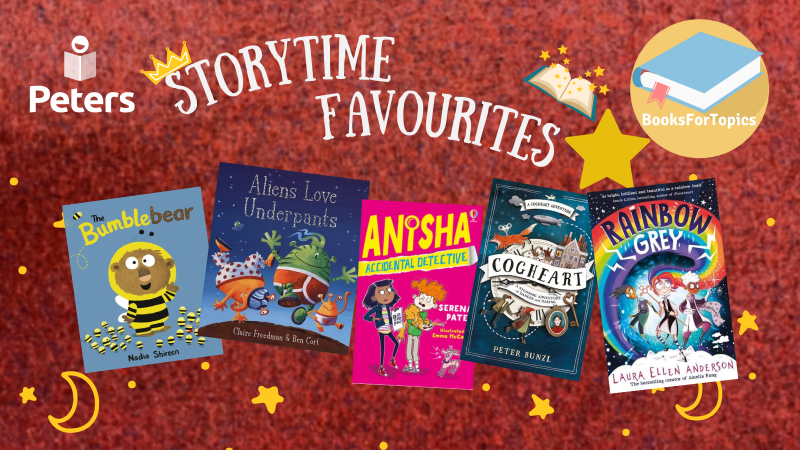For help, advice and telephone ordering call our team on 0121 666 6646
Are you sure you wish to delete this basket?()
This action cannot be undone.
Sorry, something went wrong
Please report the problem here.
Storytime favourites: what makes a great classroom read-aloud?

December 6th 2022
Research continues to highlight the importance of storytelling and storytime in bringing the magic of reading alive for pupils of all ages. However, with more than a third of parents wishing they had more time to read to their children, and 1 in 4 still unsure how often they should be reading to their child at home, it's vital that we make time for regular storytelling sessions in school to inspire pupils and support wellbeing. That's why BooksForTopics' Storytime packs contain books that are specially selected to be read aloud in the classroom – founder Alison Leach explains how their expert team choose the books below!
 |
Guest blogger: Alison Leach Alison Leach is the founder of BooksForTopics, a website that helps schools find great books to enrich their curriculums and promote reading for pleasure. As an experienced primary teacher, Alison knows that it is not always easy to source the right books and she is passionate about helping the best books reach the spotlight. You can follow @booksfortopics on Twitter. |
Some books are renowned for having that special magic that makes readers want to pick them up and browse. A catchy title, an intriguing cover or appealing illustrations can quickly entice children and draw them into the pages of a book. Teachers have told us that they love our Reading for Pleasure collections for this reason, knowing that children love to pick up and browse the curated selections for their year groups.
But sometimes what teachers ask us for is a book with a different quality – one whose magic works not as an independent read but as a class ‘read-aloud’. They ask for the kind of story in which the sound of the words and quality of the storytelling are the factors that draw the readers in. There’s no joy in the classroom quite like the joy of hearing children ask for ‘just one more chapter’ even though it’s time to go out to play. In fact, when I was teaching, my absolute favourite part of the day was storytime; I loved doing the voices, leaving the cliff-hangers hanging, drawing out the humour and – most of all – looking up at the sea of transfixed faces hanging on to my every word.
When we put together our Storytime book packs for EYFS, KS1, Lower KS2 and Upper KS2, there is a special type of book that we look to select. Our school-based review panel of teachers and librarians are quick to let us know when a book possesses all the right ingredients to make it a good read-aloud. Here are five factors that can contribute to making a story good to read out loud:
1. Storytelling that lasts between sittings
A good read-aloud hinges on the strength of its storytelling. Is the plot well structured, with a build-up of tension, the right measure of intrigue, convincing world-building and a pleasing resolution with few surprises along the way? For chapter books, teachers often read instalments of one or two chapters a day, and this works best for class storytimes if there is a strong mission or purpose driving the plot, so that listeners will easily pick up on the action when they return to each day’s instalment. We love the strong action-driven plot of Cressida Cowell’s How to Train Your Dragon, the personal family mission in The Super Miraculous Journey of Freddie Yates or the race-against-time wildlife rescue quest in When the Mountains Roared. For younger readers, unified story collections work well, so that listeners can visit a familiar character or setting in each self-contained chapter without having to hold plot elements in mind from previous days. We suggest Alf Proysen’s Mrs Pepperpot stories, Isla Fisher’s Marge in Charge or Dick King Smith’s Sophie series for this.
2. A healthy dose of laughter
Most teachers can recall storytime favourites that have led to peals of laughter from their listeners and there’s nothing that unifies a class quite like a shared bookish in-joke. Research has shown that people who laugh more are prone to being healthier, less affected by stress or depression and have better immunity - so it follows that providing opportunities to laugh as a class really is beneficial to children and adults alike. Among your storytime repertoire, do you have books that provide a much-needed giggle at the end of the day? For upper KS2, we suggest Llama Out Loud or The Boy Who Made Everyone Laugh, or for lower KS2 we love Sam Copeland’s Charlie Changes Into a Chicken.
3. Something to think about
Stories can serve as a springboard to delve into more complex topics, such as bullying, mental health, climate change or grief. Many teachers like to use the opportunity of storytime to provide a safe environment to discuss difficult topics. This may not be appropriate for every story selected to read aloud to a class, but balancing the selection across the year in order to sometimes provide stories exploring tricky topics can provoke deep thought and lead to rich and meaningful discussions. The Last Bear or The Song of the Dolphin Boy are popular choices for exploring climate change with KS2, while Race to the Frozen North or Amari and the Night Brothers can lead to discussions about race, civil rights and social inequality.
4. The rich language of storytelling
A classic mistake is to choose a story that relies too heavily on pictures. There’s a time and a place for capitalising on the power of illustrations in literature and books with a strong visual element often make great independent reads, 1-1 storytimes or class study texts - where children can see the pictures close-up. But for a whole class read-aloud, the tricky logistics of enabling all children to see the illustrations well mean that the books that work best are those with a story that unfolds through text. The best read-alouds are told through high quality and age-appropriate language that paints a strong picture in the mind of the listener and the books on our Storytime Read Aloud booklists have been selected with this in mind. We love Nizrana Farook’s evocative descriptions of the Sri Lankan setting in The Girl Who Stole an Elephant, or Peter Brown’s convincing world-building in The Wild Robot.
5. A pinch of peril
Teachers need to make a judgement call on how much peril their class can handle. The safety of a classroom storytime session is a good place to introduce children to a story that is a little bit scarier than the books they might read independently. Many Year 6 classes become quickly hooked on thrillers like Orphans of the Tide, Room 13 or Jennifer Killick’s wildly popular Crater Lake (just don’t read this one on your Year 6 residential if you want the children to go to sleep!). For younger children, animals are often the vehicle for delivering a dose of danger followed by a safe resolution - try Charlotte’s Web or the Animals of Farthing Wood for lower KS2, and Harry the Poisonous Centipede or Martin’s Mice with KS1.
Providing a balance across the year is the key to keeping story times fresh and enjoyable, and as teachers and librarians get to know their classes well they can make a judgement call on how to hone their choices. All of the texts suggested in this blog post are part of our Storytime book packs, which can be viewed and purchased here. Class story times are shared experiences that have the potential to be a magical bonding time for adults and children, and often are eagerly anticipated by children.
In the words of Sir Michael Morpurgo, “Let there be half an hour of story time at the end of school in primary schools up and down the country. Make this the half hour they all long for, that they don't want to be over. Let the children go home dreaming of the story, reliving it, wondering.” By making quality selections for story time texts, teachers will be one step closer to this goal.
Order BooksForTopics Storytime packs
read next: win £5000 worth of books for your library with The Royal Mint's short story competition








